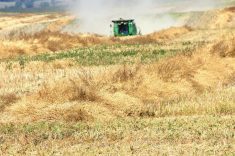Much needed ammunition in the fight against a devastating type of wheat stem rust, Ug99, is expected by early next year.
Scientific research is expected to yield new wheat genes to provide this breakthrough.
Mike Bonman, a plant researcher with the Small Grains and Potato Germplasm Research Unit in Aberdeen, Idaho, has been screening more than 3,000 wheat landraces. Landraces are varieties that have been selected by farmers over the centuries and are usually adapted to specific ecosystems.
He has found several hundred varieties that show great potential against stem rust. But the age of the varieties prevents their immediate use in modern wheat production, said Bonman.
Read Also

Alberta researcher helps unlock the economics of farming
Lethbridge Polytechnic researcher helping agriculture producers with decision-making tools in economic feasibility
He said the ancient lines tend to grow too tall or mature too late for modern use.
Bonman believes the discoveries are significant because their genetic properties have potential to lead to a long-term breakthrough in the fight against Ug99.
“We have a big task ahead of us to determine if these are novel genes or perhaps it is something we already know about,” said Bonman.
“We test in the greenhouse … on seedlings and then we test in the fields in Kenya…. I would say it takes about another year to confirm resistance.
“We want to provide plant breeders with not just a single gene but many resistant genes they can use to help combat this problem.”
He said with pathogens like Ug99, it is important to have more than one resistant gene to achieve long-term resistance.
Tom Fetch, a plant pathologist with Agriculture Canada, said western Canadian spring and durum wheat lines are resistant to stem rust strains common to North America.
Fetch has been carrying out tests using Canadian wheat varieties to pinpoint specific varieties with potential for resistance to Ug99 and related strains.
“I did 69 spring wheat lines in Western Canada and out of those 69, I have two cultivars that would be rated as very resistant to Ug99,” said Fetch.
These two Ug99 resistant lines are from the AC Cadillac and Peace wheat varieties.
Since its initial discovery in the East African countries of Uganda, Kenya and Ethiopia, Ug99 or closely related strains have been reported in several other countries. It is feared that as the disease spreads, it will eventually affect wheat and barley crops in North America.














